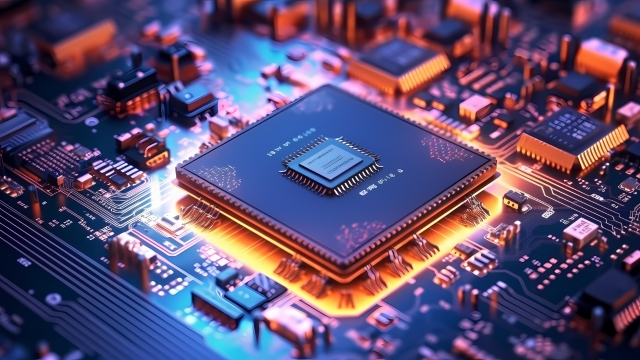A Real-Time Operating System (RTOS) is a key part of many embedded systems. An RTOS swiftly switches tasks, simulating simultaneous program execution on a single core while managing resources and processor time to ensure tasks run smoothly. Using an RTOS in an embedded system can greatly improve the system’s efficiency, reliability, and performance. It simplifies design, aiding developers in managing complexity, but an RTOS isn’t universally suitable.. It has pros and cons and should be used based on the project’s specific needs. In this blog post, we will see what RTOS is; we will look at its characteristics, types, pros, and cons. We will also compare it with bare metal programming and its use in embedded designs.
What is Real-Time Operating System (RTOS)?
A Real-Time Operating System (RTOS) handles events in real time with a level of consistency and predictability that general-purpose operating systems can’t.An RTOS guarantees that tasks will be processed within a certain time frame (often milliseconds), and any delay can be disastrous, especially in time-critical industrial systems and microcontrollers.
Characteristics of a Real-Time Operating System
Features of a Real-Time Operating System An RTOS has several key features that distinguish it from a general-purpose operating system:
Hard vs Soft RTOS: RTOSes are divided into soft and hard real-time systems. Soft RTOSs are for a few hundred milliseconds, and hard RTOSes are for tens of milliseconds. Hard RTOSs have small or medium-sized files.
Multitasking: An RTOS can switch between tasks quickly and do multiple things simultaneously. This is done with a scheduler that decides which task to run at any given time.
Inter-task Communication: RTOSs have mechanisms for tasks to talk to each other. This can be done with message queues, mailboxes, and pipes.
Memory Management: An RTOS has features for memory management, like memory allocation and deallocation.
Interrupt Handling: In an RTOS, high-priority tasks can interrupt low-priority tasks. This is important in real-time systems where some tasks must be executed immediately.
Many applications use RTOSes, including embedded systems, industrial automation, and transportation. Developers design them to provide predictable and deterministic performance for real-time applications.
Types of Real-Time Operating Systems
Real-Time Operating Systems (RTOS) can be divided into three main categories based on their scheduling logic and how they handle tasks and resources. These are:
Hard Real-Time Operating System
A Hard RTOS always completes specific tasks within a particular time. Missing a deadline is a system failure. This type of RTOS is used in environments where a task delay can mean disaster. Examples are scientific experiments, medical imaging, industrial control systems, weapon systems, robots, and air traffic control systems.
Soft Real-Time Operating System
A Soft, Real-Time Operating System also meets deadlines, but a missed deadline is not fatal. It prioritizes data throughput over task completion time. Soft RTOS is used in systems where data streaming is essential, like multimedia applications and digital audio systems. It uses priority-based preemptive scheduling.
Firm Real-time Operating System
A Firm Real-Time Operating System (RTOS) mixes hard and soft RTOS. In these systems, missing a deadline is undesirable and may degrade its performance, but it is not fatal. Firm RTOS is used in systems where occasional missed deadlines are acceptable, but consistent failures would significantly affect system quality. Examples are multimedia applications.
Advantages and Disadvantages of Using an RTOS
Like any technology, an RTOS has pros and cons. Knowing these will help you decide whether to use one in your embedded system project.
Benefits of Using an RTOS in Embedded Projects
- Precise and Reliable Performance: RTOS provides a predictable and consistent response to events, critical in real-time applications where timing is everything.
- Multitasking: RTOS can multitask efficiently and run multiple applications simultaneously.
- Control Over Hardware Resources: RTOS manages system resources, CPU time, memory, and peripherals.
- Handle Multiple Tasks: RTOS makes it easier to scale your system as it grows by providing the means to manage more tasks.
Potential Drawbacks of Using an RTOS
- Limited Flexibility: It may not be as flexible as a custom-built system designed specifically for your application.
- High Complexity: An RTOS can add complexity to your system, as it requires a deep understanding of real-time concepts and the specific RTOS you are using.
- High Cost: Commercial RTOSs can be expensive, and even free RTOSs have associated costs, such as the time needed to use them effectively.
- System Complexity and Development Costs: The use of an RTOS can lead to increased system complexity, which can in turn lead to higher development costs.
Choosing an RTOS
Selecting the right RTOS for your embedded system project is a big decision that can impact the system’s performance and the development process. Here are some things to consider:
RTOS vs. GPOS: Key Differences and Considerations
General Purpose Operating Systems (GPOS) like Windows or Unix are designed to handle many tasks and applications. They can run multiple tasks concurrently but may not be suitable for critical, time-sensitive applications due to latency and synchronization issues. An RTOS is designed for real-time applications where determinism is required. RTOSs provide a deterministic, hard real-time response to get a quick reaction to events. The choice between an RTOS and a GPOS will depend on your project’s requirements.
Factors to Consider When Selecting an Operating System
When choosing an RTOS, several things to consider are performance, reliability, scalability, security, and support. These significantly affect how well the RTOS will fit your project. For example, performance and reliability are critical for systems where time is of the essence, and scalability is essential for projects that will grow in complexity over time. Security is a big concern in this connected world, and support is gold dust when dealing with complex systems.
Benefits of a Commercial RTOS vs. Open Source
Commercial RTOSs offer many benefits, such as enhanced security, scalability, and reliability. They come with professional support, extensive documentation, and guaranteed updates. But they are expensive. Open-source RTOSs are free and can be modified to fit your needs. They have active communities that can provide support. But they don’t offer the same level of security and reliability as commercial RTOSs. The choice between commercial and open source will depend on your project’s needs and budget.
RTOS vs Bare Metal Programming
When developing an embedded system, one of the key decisions you’ll need to make is whether to use an RTOS or bare metal programming. Both approaches have advantages and disadvantages, and the best choice depends on your project’s specific requirements.
| S.NO | Category | Bare Metal | RTOS |
| 1 | Control | Full control over hardware | Abstraction layer; less control. |
| 2 | Complexity | Higher complexity, manual resource handling. | Simplifies complex systems, and adds unnecessary complexity for simple ones. |
| 3 | Efficiency | Very efficient, with no OS overhead. | Adds memory and CPU overhead. |
| 4 | Features | No multitasking or advanced features | Supports multitasking, communication, scheduling |
| 5 | Use Cases | Best for simple systems, and low-level tasks. | Ideal for complex, real-time applications. |
| 6 | Advantages | Lightweight, direct hardware access. | Predictable performance, multitasking, resource management. |
| 7 | Disadvantages | Time-consuming, no built-in features. | Overhead, increased complexity, resource usage. |
| 8 | Development Time | Longer for complex tasks | Faster for complex systems, slower for simple ones |
| 9 | System Resources | Minimal usage | Higher resource consumption due to OS |
The Use of RTOS in Embedded Designs
Using a Real-Time Operating System (RTOS) in embedded system design makes life easier and faster. However, some common misconceptions about RTOS can confuse or mislead.
One common misconception is that RTOS is only for complex systems with many tasks. While it’s true that RTOS simplifies task management for many tasks, it also helps simpler systems. For example, even in a system with a single task, RTOS gives you a deterministic response to events, which is critical. Another misconception is that using RTOS will automatically make your system real-time.
Designers create an RTOS to be real-time, but the actual real-time behavior of the system depends on the tasks and the RTOS features used. When used correctly, an RTOS can bring many benefits to embedded system design.
It provides a framework for your application and handles low-level tasks such as task scheduling and resource management. This can make development easier. An RTOS can also improve system performance by managing tasks and resources efficiently and system reliability through features like error detection and recovery. An RTOS can make debugging more accessible by providing system visibility and traceability.
RTOS Use Cases & Applications in Industry
Many industries use Real-Time Operating Systems (RTOS) where determinism is critical. In aviation, engineers use RTOS in flight control and navigation systems. Medical equipment like heart rate monitors and ventilators use RTOS for real-time response and reliability. Industrial control systems like automation and robotic systems get the efficient multitasking of RTOS. The automotive industry uses RTOS in engine control units and advanced driver-assistance systems. Finally, telecommunications systems like network routers and switches use RTOS for high performance and reliability. These are just a few examples of where and why you would use an RTOS.
RTOS Design and Architecture
The design and architecture of an RTOS are key to deterministic behavior and task management. The architecture of an RTOS has a kernel that handles task scheduling, interrupt handling, and inter-task communication. The design principles of an RTOS are accurate time response, efficient multi-tasking, and robust error handling. Several disciplines impact real-time systems, computer science, electrical engineering, and systems engineering. These disciplines cover hardware, software, and system integration.
Considerations for Safety and Security
Its’ key in an RTOS. Safety ensures the system functions despite hardware or software failures. That’s redundancy, error detection and recovery, and fail-safe design. Security is about protecting the system from attacks. That’s secure boot, encryption, and access control. You must design an RTOS with both safety and security in mind, or you’ll have a disaster on your hands.
Embedded Software and RTOS Integration
When you integrate an RTOS with your embedded software it can be tricky. Complexity, real-time performance, and hardware constraints are all issues to consider. You need to have a good understanding of the system requirements, the RTOS, and the hardware. Common business challenges with RTOS are the cost of the RTOS, the time to learn how to use it, and the need to comply with industry standards and regulations.
Conclusion
RTOS provides real-time response in my applications. Whether you are in the aviation industry, medical equipment, industrial control systems, or telecommunications, an RTOS can boost your system performance and reliability. Integrating an RTOS into your project can be a complex task. You need to have a deep understanding of the RTOS and your system. This is where Devomech Solutions can help.
We provide advanced technology solutions, including RTOS integration in embedded systems and Internet of Things (IoT) development. Our experienced team designs, implements, and optimizes RTOS-based systems. We know the challenges of integrating an RTOS with embedded software and can handle them so your system will be optimal and reliable. If you are considering using an RTOS in your project, contact us, and let’s create innovative and high-performing solutions that fit your needs.

